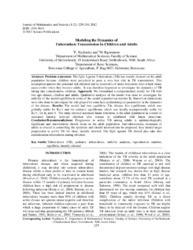Modeling the dynamics of tuberculosis transmission in children and adults
Abstract
Abstract: Problem statement: The fight Against Tuberculosis (TB) has mainly focused on the adult population because children were perceived to pose a very low risk in TB transmission. This assumption ignores the potential risk children had as reservoirs of latent infections from which future cases evolve when they become adults. It was therefore important to investigate the dynamics of TB taking into consideration, children. Approach: We formulated a compartmental model for TB with two age classes, children and adults. Qualitative analysis of the model was done to investigate the stability of the model equilibria in terms of the model reproduction number R0 Numerical simulations were also done to investigate the role played by some key epidemiological parameters in the dynamics of the disease. Results: The model had two equilibria: The disease free equilibrium which was globally stable for R0<1 and the endemic equilibrium which was locally asymptotically stable for R0>1, for R0 near 1. The study showed increased latent infections in the adult population as a result of increased latently infected children who mature to adulthood with latent infections. Conclusion/Recommendations: Progression to active TB among adults is epidemiologically significant and interventions should focus on the adult population. Anti-tuberculosis, treatment of adults is crucial in controlling the epidemic and should interventions be proposed, they should target progression to active TB for those latently infected. The fight against TB should also take into consideration tuberculosis among children.
URI
https://thescipub.com/pdf/10.3844/jmssp.2012.229.240http://moodle.buan.ac.bw:80/handle/123456789/146
Collections
- Reseach articles [65]

